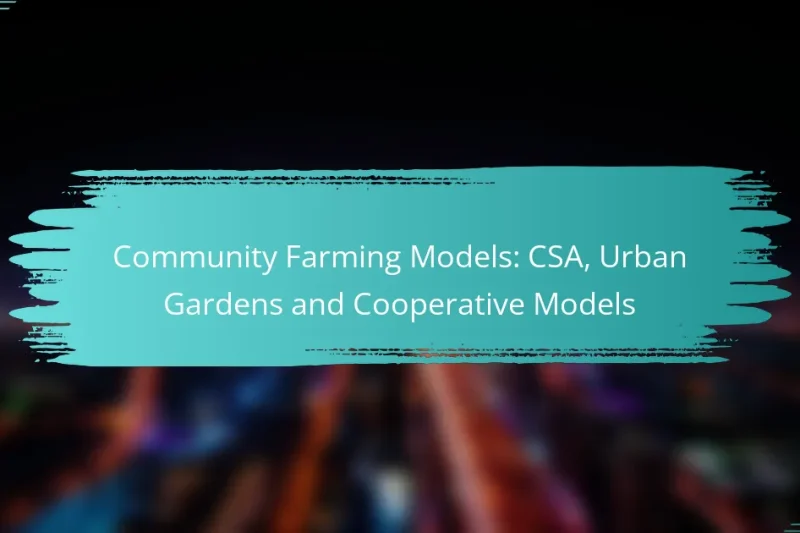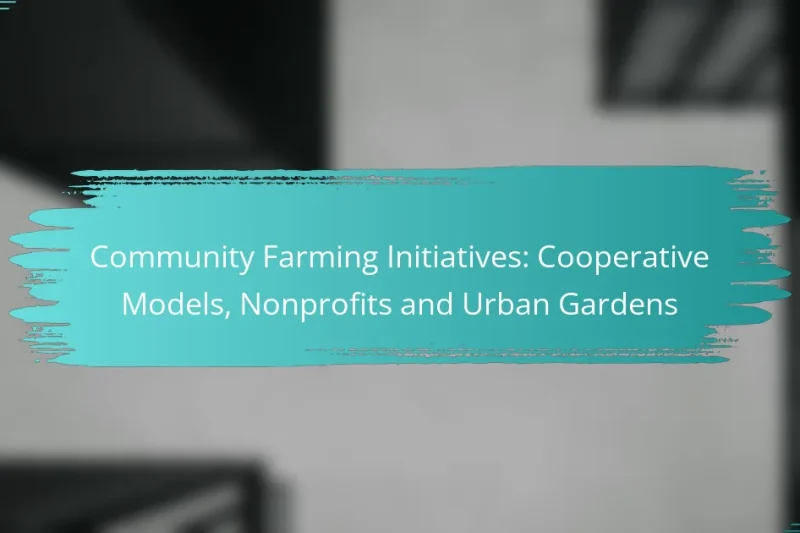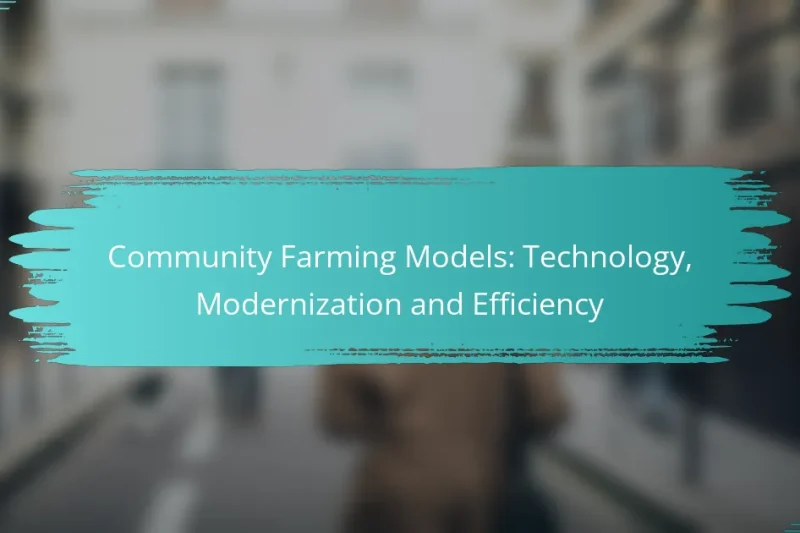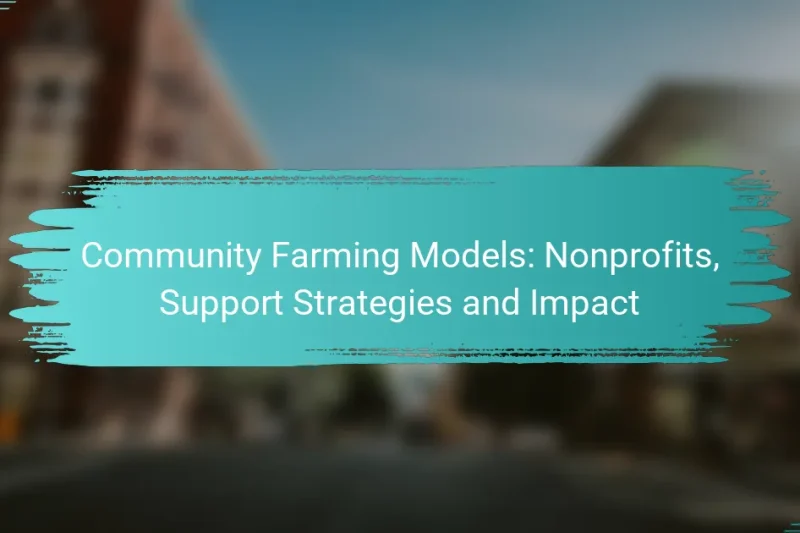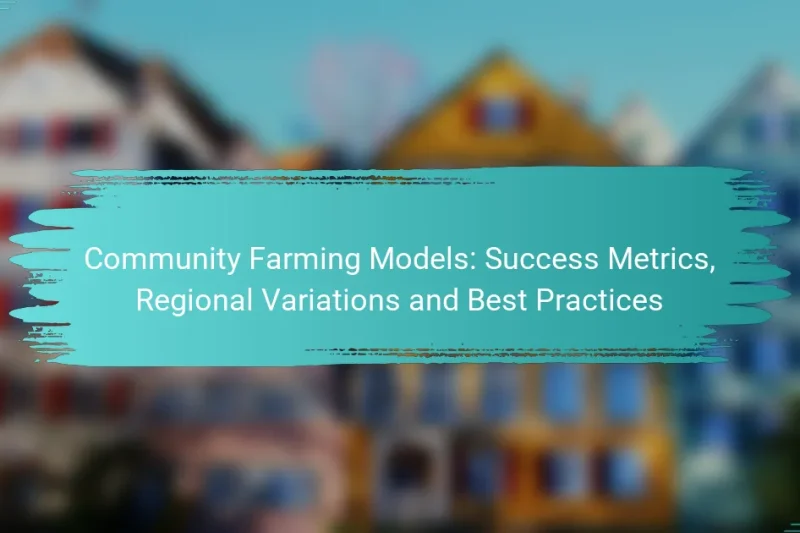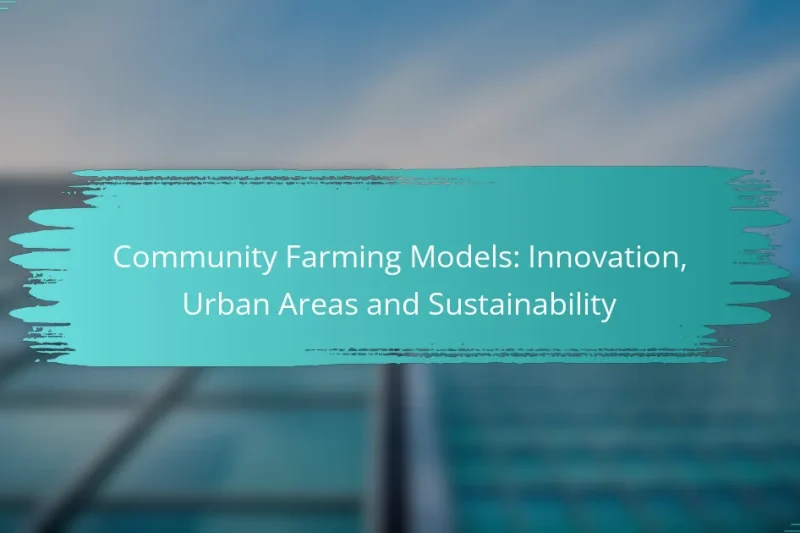Community farming models, such as Community Supported Agriculture (CSA), urban gardens, and cooperative farming, play a … Community Farming Models: CSA, Urban Gardens and Cooperative ModelsRead more
Community Farming Models Overview
Community farming models offer innovative approaches to food production that prioritize collaboration and sustainability. By fostering initiatives such as cooperative farming, community-supported agriculture, and urban farming, these models not only enhance local economies but also strengthen community bonds. However, challenges like land access and funding must be navigated to ensure their success and sustainability.
Community Farming Models: Cultural Adaptation, Community Engagement and Sustainability
Community farming models serve as a vital tool for enhancing sustainability in urban environments by encouraging … Community Farming Models: Cultural Adaptation, Community Engagement and SustainabilityRead more
Community Farming Initiatives: Cooperative Models, Nonprofits and Urban Gardens
Community farming initiatives play a vital role in enhancing urban life by improving food access and … Community Farming Initiatives: Cooperative Models, Nonprofits and Urban GardensRead more
Community Farming Models: Technology, Modernization and Efficiency
Community farming models are transforming urban agriculture by integrating technology and modernization to enhance efficiency and … Community Farming Models: Technology, Modernization and EfficiencyRead more
Community Farming Models: Nonprofits, Support Strategies and Impact
Community farming models in the United States are diverse approaches that enhance local food production and … Community Farming Models: Nonprofits, Support Strategies and ImpactRead more
Community Farming Models: Success Metrics, Regional Variations and Best Practices
Community farming models play a vital role in promoting sustainable agriculture and enhancing food security. By … Community Farming Models: Success Metrics, Regional Variations and Best PracticesRead more
Community Farming Models: Innovation, Urban Areas and Sustainability
Community farming models in urban areas are transforming the way cities approach food production and sustainability. … Community Farming Models: Innovation, Urban Areas and SustainabilityRead more
What are the key community farming models?
Key community farming models include cooperative farming, community-supported agriculture (CSA), urban farming initiatives, collective gardens, and permaculture systems. Each model emphasizes collaboration and sustainability, allowing communities to grow food collectively while addressing local needs.
Cooperative farming
Cooperative farming involves a group of individuals who come together to manage and operate a farm collectively. Members share responsibilities, costs, and profits, which fosters a sense of community and reduces individual financial risks. This model can be particularly effective in rural areas where resources may be limited.
To establish a cooperative farm, participants should create a clear agreement outlining roles, contributions, and profit-sharing. Regular meetings help maintain communication and resolve any issues that arise.
Community-supported agriculture (CSA)
Community-supported agriculture (CSA) connects consumers directly with local farmers, allowing members to purchase shares of the farm’s produce in advance. This model provides farmers with upfront capital while ensuring consumers receive fresh, seasonal produce. CSAs often operate on a subscription basis, with members receiving weekly or bi-weekly deliveries.
When joining a CSA, consider the types of produce offered and the commitment required. It’s common for shares to vary in size, so choose one that fits your household’s needs. Engaging with the farm through volunteer opportunities can enhance the experience.
Urban farming initiatives
Urban farming initiatives focus on cultivating food in city environments, utilizing available spaces such as rooftops, vacant lots, and community parks. These initiatives aim to improve food access, promote sustainability, and enhance community engagement. Urban farms can vary in scale from small community gardens to larger commercial operations.
To start an urban farming initiative, assess available land and local regulations regarding urban agriculture. Collaborating with local organizations can provide resources and support for successful implementation. Consider incorporating educational programs to involve the community and raise awareness about food systems.
Collective gardens
Collective gardens are shared spaces where community members collaborate to grow fruits, vegetables, and flowers. These gardens promote social interaction, environmental stewardship, and food security. Collective gardens can be established in various settings, including neighborhoods, schools, and community centers.
To create a successful collective garden, gather interested participants and establish clear guidelines for maintenance and decision-making. Regular workdays and social events can strengthen community ties and ensure the garden thrives.
Permaculture systems
Permaculture systems focus on designing agricultural landscapes that mimic natural ecosystems, promoting sustainability and biodiversity. This model emphasizes the integration of plants, animals, and humans to create self-sustaining systems. Permaculture practices can be applied in both rural and urban settings.
When implementing a permaculture system, start by observing the local environment and identifying natural patterns. Incorporate diverse plant species and consider water management techniques to enhance resilience. Education and community involvement are crucial for the long-term success of permaculture projects.
How do community farming models benefit local economies?
Community farming models significantly enhance local economies by fostering job creation, increasing food production, and promoting community engagement. These models leverage local resources and labor, resulting in economic growth and sustainability.
Job creation
Community farming initiatives often generate a variety of employment opportunities, ranging from farm management to seasonal labor. These jobs can be crucial in areas with high unemployment rates, providing stable income for individuals and families.
Additionally, community farms may create roles in education, marketing, and distribution, further diversifying the job market. This can lead to a more resilient local economy, as jobs are tailored to the community’s needs.
Local food production
By focusing on local food production, community farms reduce reliance on imported goods, which can be subject to price fluctuations and supply chain disruptions. This local approach not only supports food security but also encourages the consumption of fresh, seasonal produce.
Moreover, local food systems can stimulate economic activity by keeping money within the community. For example, farmers’ markets and local grocery stores benefit from the availability of locally grown products, enhancing overall economic resilience.
Community engagement
Community farming models foster a sense of belonging and collaboration among residents. They often involve community members in decision-making processes, which can strengthen social ties and promote civic responsibility.
Engagement can take many forms, such as volunteer opportunities, educational workshops, and community events. These activities not only build relationships but also empower individuals to take an active role in their local food systems, leading to a more informed and connected community.
What are the challenges of implementing community farming?
Implementing community farming faces several challenges that can hinder its success, including land access issues, funding constraints, and varying levels of community participation. Addressing these challenges is crucial for establishing sustainable and productive community farming initiatives.
Land access issues
One of the primary challenges in community farming is securing access to land. Many potential community farms struggle to find suitable plots due to high real estate prices or restrictive zoning laws. In urban areas, this can mean competing with commercial interests, while rural settings may have limited availability of arable land.
Community groups should explore options like leasing land from private owners, partnering with local governments, or utilizing vacant lots. Engaging with local authorities can also help navigate zoning regulations and identify potential land-use opportunities.
Funding and resource constraints
Funding is often a significant barrier for community farming projects. Initial costs for land, seeds, equipment, and infrastructure can be substantial, and ongoing operational costs may exceed available budgets. Many community farms rely on grants, donations, or crowdfunding to sustain their efforts.
To mitigate funding challenges, community farms can develop clear budgets and financial plans, seek partnerships with local businesses, and apply for agricultural grants. Establishing a membership model can also provide a steady income stream while fostering community engagement.
Community participation
Effective community participation is essential for the success of community farming, but it can be inconsistent. Factors such as differing interests, time commitments, and levels of engagement can affect how involved community members are in the farming process.
To enhance participation, community farms should prioritize clear communication and inclusive decision-making. Organizing regular meetings, workshops, and volunteer days can help build a sense of ownership and encourage diverse community involvement. Creating roles for different skill levels can also ensure that everyone can contribute meaningfully.
How to choose the right community farming model?
Choosing the right community farming model involves understanding the specific needs of the community, assessing available resources, and considering local environmental factors. A well-suited model can enhance participation, sustainability, and productivity.
Assess community needs
Start by identifying the primary goals of the community regarding farming. This could include food security, education, or economic development. Engaging with community members through surveys or meetings can help clarify these needs.
Consider the demographics and preferences of the community. For instance, a community with a high interest in organic produce may benefit from a model focused on organic farming practices. Tailoring the approach to fit these needs can foster greater involvement and satisfaction.
Evaluate available resources
Assess the resources at your disposal, including land, funding, and human capital. Determine if there is sufficient land for farming and whether it can be accessed legally and sustainably. Funding options may include grants, donations, or community investments.
Additionally, consider the skills and interests of community members. A group with strong gardening skills might thrive in a cooperative model, while a community with limited experience may benefit from educational workshops or partnerships with local agricultural experts.
Consider local climate
The local climate plays a crucial role in determining the types of crops that can be successfully grown. Research the average temperatures, rainfall patterns, and seasonal variations in your area to select appropriate farming practices.
For example, communities in warmer climates might focus on drought-resistant crops, while those in cooler regions may prioritize hardy vegetables. Understanding these climatic factors can help in planning for successful harvests and sustainable farming practices.
What are successful examples of community farming in the United States?
Successful examples of community farming in the United States include innovative urban farms that promote local food production and community engagement. These models often emphasize sustainability, education, and collaboration among residents.
Brooklyn Grange
Brooklyn Grange operates large-scale rooftop farms in New York City, focusing on organic farming practices. This model utilizes underused urban spaces to grow fresh produce, providing local restaurants and residents with access to high-quality food.
Key considerations for Brooklyn Grange include the logistics of rooftop farming, such as weight limits and access to sunlight. They also engage the community through educational programs and volunteer opportunities, fostering a sense of ownership and connection to the food produced.
For those looking to replicate this model, it is essential to assess local regulations regarding rooftop use and to establish partnerships with local businesses for distribution. Engaging the community through workshops can also enhance participation and support.
